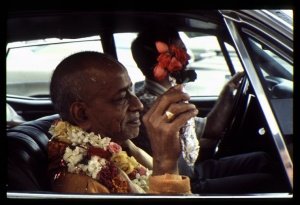CC Madhya 20.192 (1975): Difference between revisions
(Vanibot #0027: CCMirror - Mirror CC's 1996 edition to form a basis for 1975) |
(Vanibot #0020: VersionCompareLinker - added a link to the Version Compare feature) |
||
| Line 2: | Line 2: | ||
<div style="float:left">'''[[Sri Caitanya-caritamrta (1975)|Śrī Caitanya-caritāmṛta (1975)]] - [[CC Madhya (1975)|Madhya-līlā]] - [[CC Madhya 20 (1975)|Chapter 20: Lord Śrī Caitanya Mahāprabhu Instructs Sanātana Gosvāmī in the Science of the Absolute Truth]]'''</div> | <div style="float:left">'''[[Sri Caitanya-caritamrta (1975)|Śrī Caitanya-caritāmṛta (1975)]] - [[CC Madhya (1975)|Madhya-līlā]] - [[CC Madhya 20 (1975)|Chapter 20: Lord Śrī Caitanya Mahāprabhu Instructs Sanātana Gosvāmī in the Science of the Absolute Truth]]'''</div> | ||
<div style="float:right">[[File:Go-previous.png|link=CC Madhya 20.191 (1975)|Madhya-līlā 20.191]] '''[[CC Madhya 20.191 (1975)|Madhya-līlā 20.191]] - [[CC Madhya 20.193 (1975)|Madhya-līlā 20.193]]''' [[File:Go-next.png|link=CC Madhya 20.193 (1975)|Madhya-līlā 20.193]]</div> | <div style="float:right">[[File:Go-previous.png|link=CC Madhya 20.191 (1975)|Madhya-līlā 20.191]] '''[[CC Madhya 20.191 (1975)|Madhya-līlā 20.191]] - [[CC Madhya 20.193 (1975)|Madhya-līlā 20.193]]''' [[File:Go-next.png|link=CC Madhya 20.193 (1975)|Madhya-līlā 20.193]]</div> | ||
{{CompareVersions|CC|Madhya 20.192|CC 1975|CC 1996}} | |||
{{RandomImage}} | {{RandomImage}} | ||
==== TEXT 192 ==== | ==== TEXT 192 ==== | ||
| Line 18: | Line 17: | ||
<div class="synonyms"> | <div class="synonyms"> | ||
punaḥ—again; kṛṣṇa—Kṛṣṇa; | punaḥ—again; kṛṣṇa—Kṛṣṇa; catuḥ-vyūha—the quadruple expansions; lañā—taking; pūrva-rūpe—as previously; paravyoma-madhye—in the paravyoma area; vaise—resides; nārāyaṇa-rūpe—in the form of four-handed Nārāyaṇa. | ||
</div> | </div> | ||
| Line 25: | Line 24: | ||
<div class="translation"> | <div class="translation"> | ||
"Lord Kṛṣṇa again expands, and within the paravyoma, the spiritual sky, He is situated in fullness as the four-handed Nārāyaṇa, accompanied by expansions of the original quadruple form. | |||
</div> | </div> | ||
| Line 32: | Line 31: | ||
<div class="purport"> | <div class="purport"> | ||
At the top of the paravyoma, the spiritual sky, there is Goloka Vṛndāvana, which is divided into three parts. Two of the parts, called Mathurā and Dvārakā, are the residences of Kṛṣṇa in His prābhava-vilāsa forms. Balarāma, | At the top of the paravyoma, the spiritual sky, there is Goloka Vṛndāvana, which is divided into three parts. Two of the parts, called Mathurā and Dvārakā, are the residences of Kṛṣṇa in His prābhava-vilāsa forms. Balarāma, Kṛṣṇa's vaibhava-prakāśa, is eternally situated in Gokula. From the quadruple prābhava-vilāsa, twenty-four forms of the vaibhava-vilāsa are expanded. Each has four hands holding weapons in different positions. The topmost planet in the spiritual sky is Goloka Vṛndāvana, and below that planet is the spiritual sky itself. In that spiritual sky, Kṛṣṇa Himself is four-handed and is situated as Nārāyaṇa. | ||
</div> | </div> | ||
Latest revision as of 12:51, 27 January 2020

A.C. Bhaktivedanta Swami Prabhupada
TEXT 192
- punaḥ kṛṣṇa catur-vyūha lañā pūrva-rūpe
- paravyoma-madhye vaise nārāyaṇa-rūpe
SYNONYMS
punaḥ—again; kṛṣṇa—Kṛṣṇa; catuḥ-vyūha—the quadruple expansions; lañā—taking; pūrva-rūpe—as previously; paravyoma-madhye—in the paravyoma area; vaise—resides; nārāyaṇa-rūpe—in the form of four-handed Nārāyaṇa.
TRANSLATION
"Lord Kṛṣṇa again expands, and within the paravyoma, the spiritual sky, He is situated in fullness as the four-handed Nārāyaṇa, accompanied by expansions of the original quadruple form.
PURPORT
At the top of the paravyoma, the spiritual sky, there is Goloka Vṛndāvana, which is divided into three parts. Two of the parts, called Mathurā and Dvārakā, are the residences of Kṛṣṇa in His prābhava-vilāsa forms. Balarāma, Kṛṣṇa's vaibhava-prakāśa, is eternally situated in Gokula. From the quadruple prābhava-vilāsa, twenty-four forms of the vaibhava-vilāsa are expanded. Each has four hands holding weapons in different positions. The topmost planet in the spiritual sky is Goloka Vṛndāvana, and below that planet is the spiritual sky itself. In that spiritual sky, Kṛṣṇa Himself is four-handed and is situated as Nārāyaṇa.